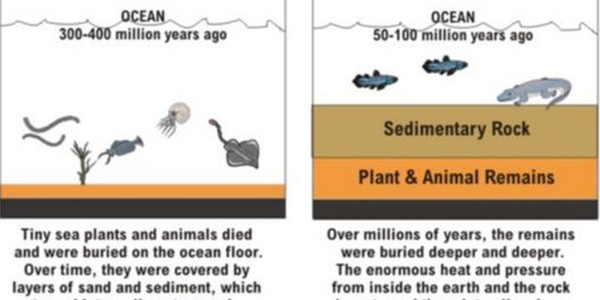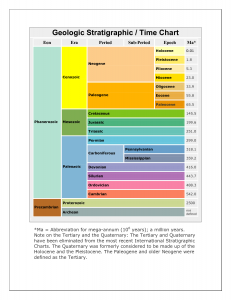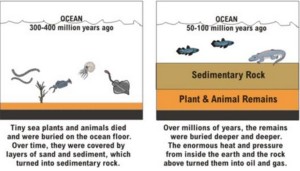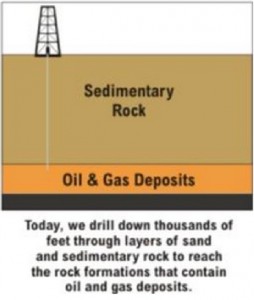How is oil formed? Part 2 – Geologic past
For you to understand how oil is formed, it is important to understand the geologic past.
The geologic past is measured by means of a Geologic Time Chart. Each interval of time has been given a name so that a particular time in the past can be referred to more easily. In recent times, we refer to periods in history with therms such as the “ice age”, “stone age”, “iron age”, or “industrial age”.
Millions of years or thousands of years?
But, since you are looking at millions of years, there are different terms. During the last 5 billion years seas and mountains have come and gone and there have been drastic temperature changes. Our world has changed quite a bit over the stretches of time.
Another way of looking at this is that God created Adam and Eve with age. They were fully grown the moment they were created. Could he have done the same with the earth? We know that with God, everything is possible (Matthew 19:26).
Basins
But, geologists try to merely describe what they see and test. And, it appears that there were ancient bodies of water in areas that do not exist today. They were seas, gulfs, or embayments. Now, they are referred to as “basins”.
In the past, as now, when a river flowed into a body of water, the coarser sediments such as sand settled to the bottom first and nearer the mouth of the river. The lighter sediments such as mud and silt were carried farther out into the body of water and deposited in deeper water.
In warm climates lime is another type of sediment deposited. As the lime hardens into rock, it is known as limestone. Limestone also comes from what was once a coral reef found in warm shallow tropical water.
Limestone, along with sandstone, is a very important rock for producing oil and gas. In fact, a limestone reef is usually better than a sand one because of the larger pore spaces present.
Teeming with life
In these ancient ages, the oceans were, as they are now, teaming with life. Some are visible and some are microscopic. When the organisms die, they sink to the bottom and mix with mud and silt. Over the ages, tons and tons of these organisms died and mixed with the mud/silt at the bottom creating large layers of this mixed organic compound.
Mixing and moving
Yet, we also know that the earth is moving – rising, sinking, and sliding in various directions. As the land rises, the sand from the rivers is deposited farther from the original shore and is deposited on top of the mud and organisms. Then after millions of years pass (according to science), the land starts to sink again and the seashore gets back to its original position, thus depositing mud again and again, eventually there will be alternating layers of mud, silt, sand and lime present.
A lot of pressure
The tremendous weight of these sediments will cause the mud, which is softer, to be compressed into only a fraction of it’s original thickness. Chemical reactions of bacteria, pressure, and temperature will cause the organisms to change into oil.
You might say oil is formed by the juices of these small “bugs”.
This is a theory of course since no one (except the ONE) was around to witness the process, but it is the one that is most accepted (among other like this one). It is known as Organic Theory.
Some have estimated that it takes as much as 200 feet of “bugs” compressed together to get 1 inch of oil!
Squeezed into the sand
As more and more sediments are dumped on top of the existing sediments, the mud becomes more and more compressed and will turn into a rock known as shale. The sand turns into sandstone, the silt turns into siltstone, and the lime turns into limestone (yes, they were creative with the names).
As the mud becomes compressed into shale, the oil is squeezed out of the shale and into the pore spaces between the sand grains of the sandstone or the pore spaces in the limestone. The larger pore spaces of the limestone and sandstone will accommodate the oil more readily.
So, the mud or shale has been the source of the oil and the sandstone or limestone acts as the reservoir to hold the oil.
VIDEO: A quick explanation of this process









[…] post How is oil formed? Part 2 – Geologic past appeared first on Zion Oil and Gas, […]